I suspect most of those reading this have never heard of John Fleetwood. Recently someone described John as 'quietly getting on with doing extraordinary mountain journeys with zero fanfare', which about sums him up. Behind that 'extraordinary' hide a few other adjectival phrases, of which perhaps the most important is 'preferably in winter', yet his accounts of these ventures are a bit understated. So here is one mortal's peripheral story of the Strathfarrar Watershed.
I first met John some fifteen years ago in the Christian Rock and Mountain Club. Hillrunning wasn't yet on my personal radar, the shared passion was mountains and climbing. John was a determined (some might even say driven!) winter climber and an alpinist, and though to my recollection I only ever climbed with him on the same rope once (he was climbing much harder stuff than I even aspired to), there were many shared trips, drams, songs and stories (and vegetarian curries; John was about the only vegetarian I knew in those days, and so always volunteering to take care of the food).
As all of my friends, present and past, would undoubtedly readily confirm, I am not very good at keeping in touch, and so we lost contact for a number of years. Time passes rather fast, bringing with it some significant birthdays among the old CRMC crowd, and a reunion meet in the Yorkshire Dales couple of years ago.
By then, hillrunning had become my main passion, and I was (still/again) training for the Assynt Traverse. John was just back from a rather epic traverse of the Alps, and there was much to talk about. I never talked running with John before, and realised quickly that we share a very similar take on it, though we practise it on quite different levels. And he was the first (and last) person that I came across who knew exactly what the Assynt Traverse was!
Consequently, when John got in touch at the start of this year about his plans to attempt a winter traverse of the Strathfarrar watershed, I readily agreed to go along. All we needed was a good dump of snow, which a storm at the end of February helpfully provided. And so on the morning of the 27th we find ourselves at the gate on the Glen Strathfarrar private road. (And if you intend to read any further, I suggest you read John's account before carrying on, what follows will make more sense.)
There was never any question of me accompanying John. Even at the peak of my physical condition this outing would be well beyond my limits, and I am not even remotely at my peak. And so as John heads up the little farm track to gain the hills north of the glen, I assemble my bike and set off along the road. The plan is to cycle to Monar Lodge, run along Loch Monar to gain the high ground over Creag na Gaoithe, eventually joining John's route at Bidean an Eoin Derig; follow it to the Maol-bhuidhe bothy where we will meet, for some warm food, dry clothes and spare batteries. Then, perhaps, I'll accompany John for a bit up to Sgurr na Lapaich, before making my own way down to Monar Lodge to pick up the bike ...
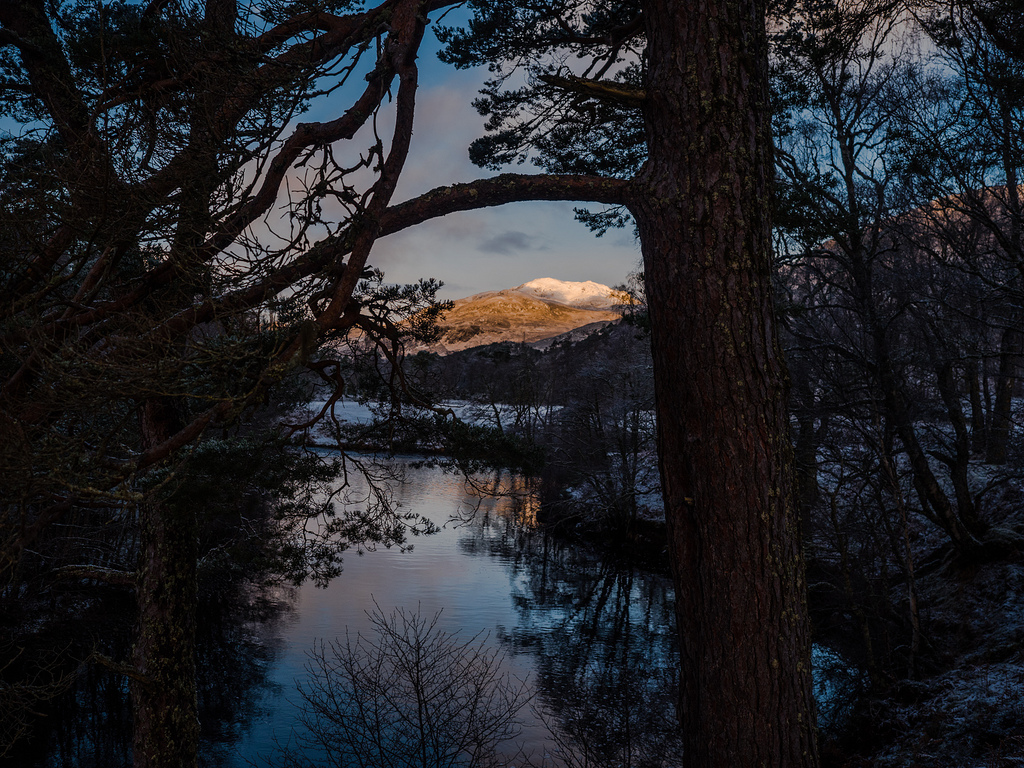
But that's all still ahead of us. It is a crisp morning, promising a clear sunny day ahead. An inch or so of snow on the road makes the cycle quite arduous, though the stunning scenery is more than making up for that. But soon my feet are freezing, and I can't think of any explanation why I packed SIDI racing shoes rather than Specialized Defroster winter boots. By the time I reach the far side of Loch a'Mhuillidh, I can't feel my toes and have to stop to put on an extra pair of socks, which helps a bit.
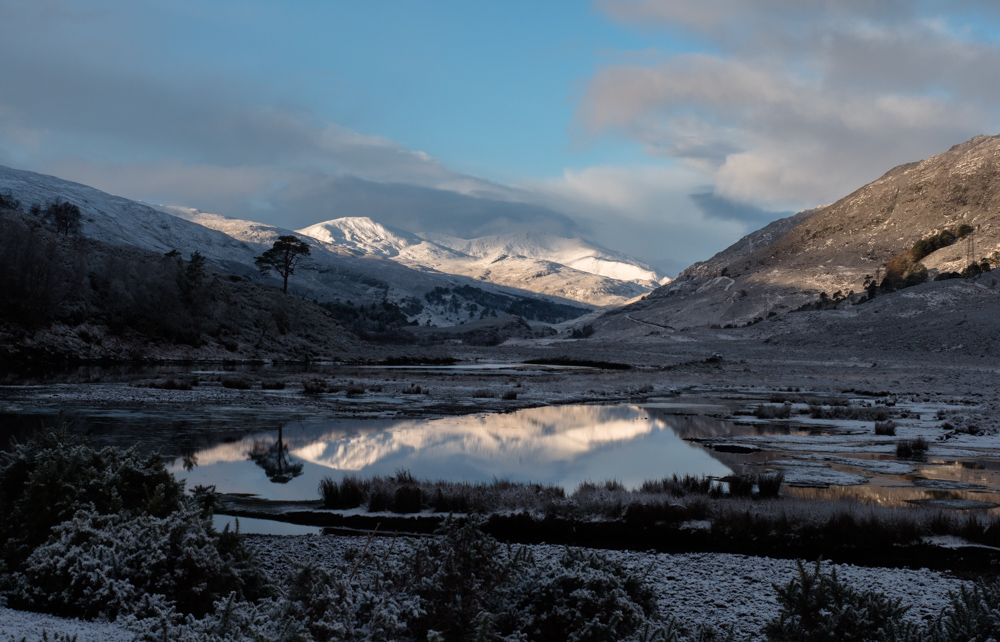
The glen is full of deer, there must be thousands of them, feeding on the hay the estate provides. They are somewhat unpredictable, particularly the younger bucks, and so care is needed, especially where the road splits the herd. I slowly gain height, there is more snow, and some pushing to be done, before I reach the lodge -- the 25k or so takes me some three hours, a lot longer than I expected.
After a quick early lunch basking in sunshine, I put on my mudclaws and set off along the loch. The sky is blue, no cloud to speak of, the loch like a mirror -- the centre of the high pressure must be bang on the top of here.
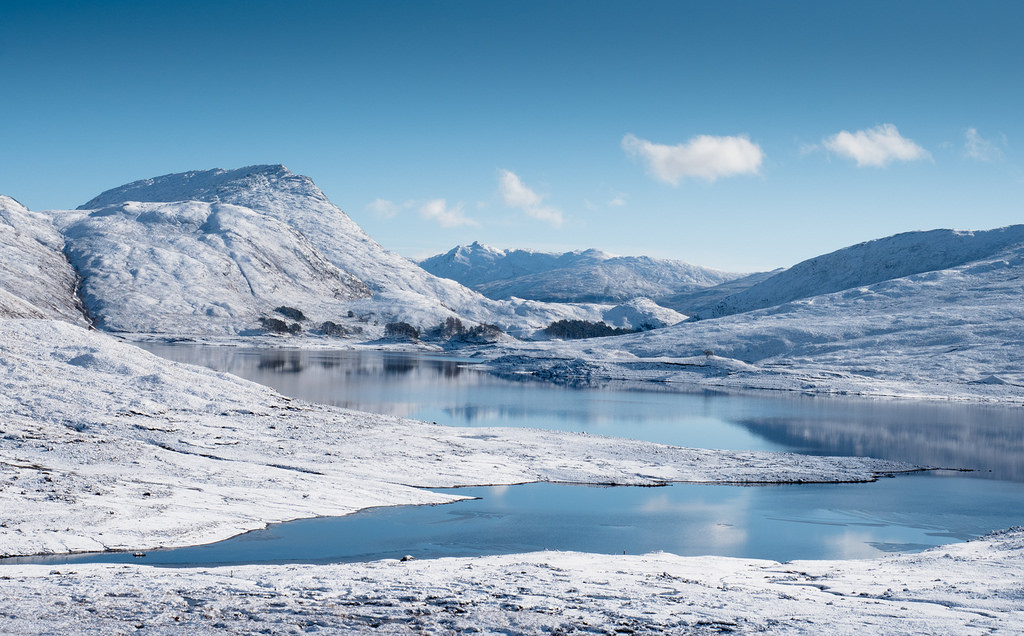
The jog is very pleasant, though the temperature has crept up a bit, melting the snow, and so for the entire 10km I run in an inch or two of ice-cold water. I don't mind, days like these don't come around often, and I think the cold feet a price worth paying.
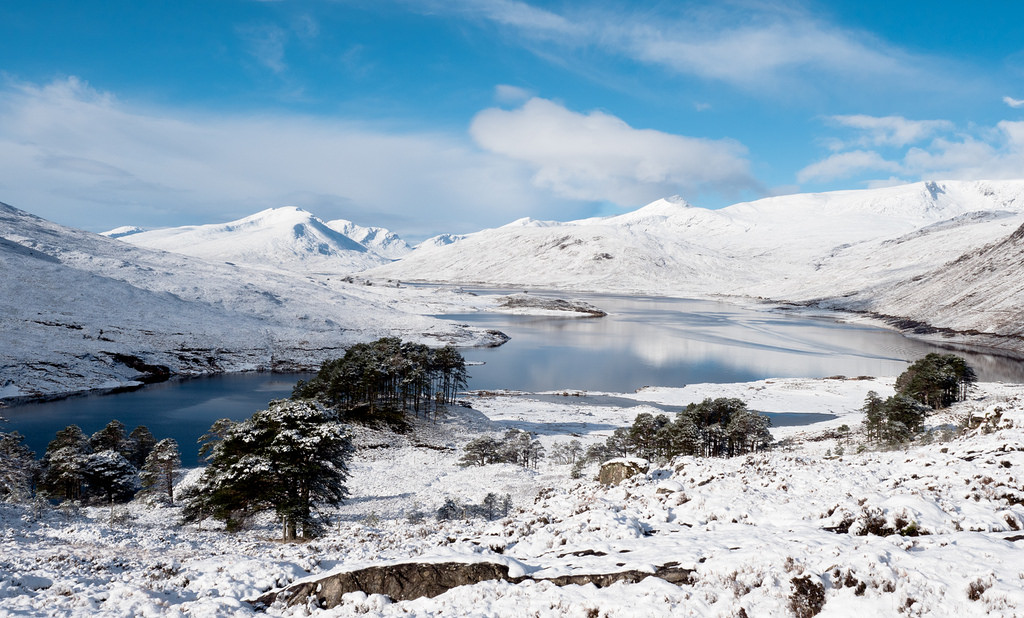
When I eventually stop for some oatcakes and cheese at the foot of Creag na Gaoithe, a wisp of cloud appears from somewhere and it suddenly gets rather cold. I don't hang around and start plodding up.
The snow on the sun-exposed hillside is saturated with water, and my cold feet are doing my head in: I start worrying about the inevitable temperature drop on the higher ground, about how far I still have to go today ... in this game, the head is everything.
Nevertheless, the sun is back out on the ridge, surface frozen and runnable, my feet warming up quickly. I pause briefly at the foot of the arrete that leads to the summit of Bidean an Eoin Deirg, wondering if I need to put on crampons, settling for an ice axe only, and quickly regretting it. Conditions are tricky, and exposure on both sides considerable. And, of course, now I am in a place I can't put them on ... I carefully backtrack onto a small platform lower down -- how many times over the years have I got caught out like this?
A bite to eat on the summit, then over to the Sgurr a'Chaorachain trig point. There are some footprints here, and I nearly descend down the N ridge by mistake following them. But I realise quickly enough. The compass comes out to double check, for in the afternoon light the climb out of Bealach Coire Choinnich onto to Sgurr Choinnich seems improbably steep and monolithic. I even briefly contemplate dropping down into Coire Choinnich to avoid it, but the slope there is obviously heavily loaded, the risk of triggering an avalanche high.
As it happens, the ascent is straight forward, the ground at an amenable gradient (as the map clearly shows), but the snow is deep, at times waist deep. I don't even pause on Sgurr Coinnich, I am well behind schedule, reaching Bealach Bhernais exactly at sunset.
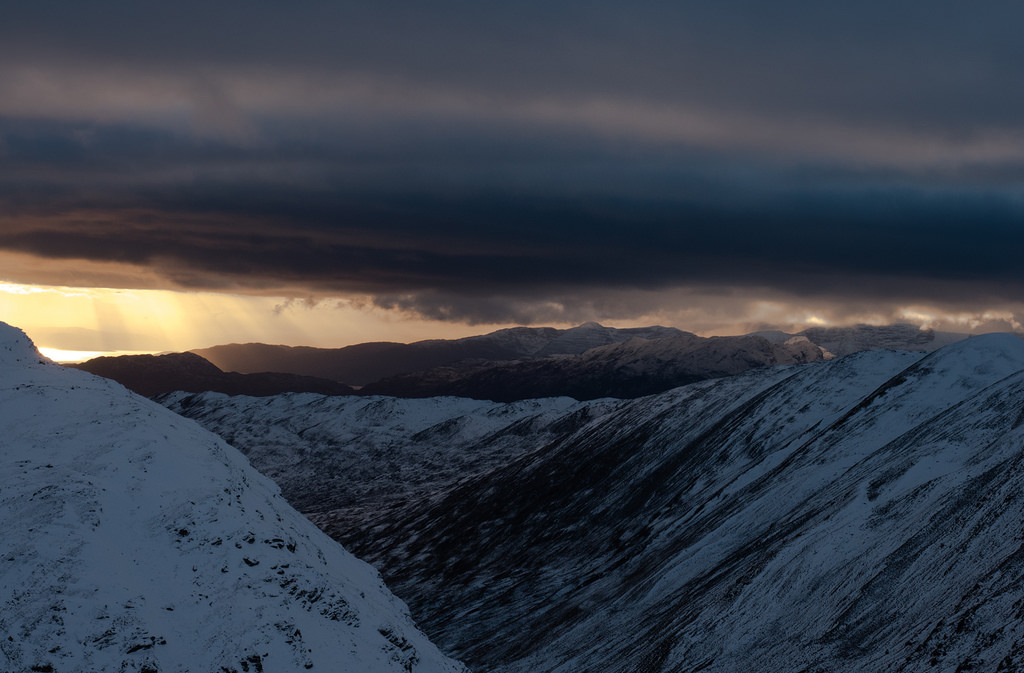
There are decisions to be made. The next section of John's route is difficult navigation-wise, and the deep snow will make progress hard. I have no idea how far behind me John is, but I do know that should he catch up with me I could not keep up with him. But more than anything, I am tired, have been on my feet for over nine hours, and my lack of fitness is beginning to show.
I decide to take the bailout route -- there really is only one such option today, and it's here in Bealach Bhernais. I should say, this is not something I am desperately devising here in the dropping temperature while watching the stunning sunset. Rather, it is something we discussed over a vegetable curry the previous night in the warmth of the (most excellent, would recommend to a friend) Black Isle Berries Bunkhouse. On these big winter ventures planning is key to survival, and John's planning is nothing if not meticulous.
The bailout route means heading west to pick up the stalker's path that leads into Coire Beithe, following this past Loch an Laoigh to eventually pick up the path into Coire na Sorna, past Loch Calavie and down to the bothy over open hill. It's still 17km or so to go, but an easy 17km compared to the watershed line.
I enjoy the sunset, then get the head torch out and reset the altimeter. The initial descent is awkward, and the stalker's path hard to locate, but once I do, it is a decent pony track, and to my surprise I am running rather well down the gentle gradient. Once I get beyond Loch an Laoigh, I find a huge track where the map indicates a path.
After a short while my head torch beam starts picking up some strange, spooky aberrations ahead. This turns out to be heavy machinery, with high vis jackets left hanging on the operator seats. Even in the darkness, I am saddened by the intrusion, we do not value landscape anywhere near enough in this wee country of ours.
There is only one small snag with the bailout route: when I printed out my map at home, I didn't print enough of it. I am missing perphas no more than 1/2 km, but unfortunately it includes the place where the Coire na Sorna path leaves the track I am on. To avoid dropping too low and off my map, I decide to leave the unenjoyable track early and head for the open hillside. The Sorna path is, in fact, yet another big track, which I intersect at around the 300m contour line.
A short climb, then the track levels out, Loch Calavie should be on my right. Yet my (reasonably powerful BD Icon Mk I) head torch beam is not picking it up. There seems to be just a black bottomless abyss there. This is disconcerting. I stop to check the map. It turns out I am standing no further than a foot away from the edge of the water, I can hear it splashing when I am still, but somehow if I shine my beam further out, there is no reflection whatsoever. Spooky.
I carry on, and, not being able to see the loch that well, I miss its eastern end, where another path I want to take branches off. But I am sufficiently alert to realise almost immediately when the main track starts climbing again. The foot of the loch is a proper peat bog, and it takes me a while to negotiate it, before a brief spell on the new path. Then on a bearing down to Loch Cruoshie. There are a few obvious re-entrants here, serving as useful tick offs, and my navigation is bang on.
The final unknown is whether the outflows from Loch Cruoshie will be manageable to cross or not. There is an alternative, but it means a fair detour which I would prefer to avoid. They are freezing, knee deep, but very mercifully slow flowing. Not far to go now, perhaps the reason why I become somewhat complacent about navigation even though there is a thick mist hanging around. As a result locating the bothy takes me longer than it should have, not ideal after wading through the icy water. I am much relieved when I finally spot its outline at the far reach of my head torch beam.
It's 10.45pm and I am glad this 15h day is at an end. I have a quick look around. There is a wheel barrow in the 'utility room', with what looks like a sack of coal in it -- if wishes were horses ... I don't know who gets a bigger fright, whether me or the mice sheltering in it; alas no coal. I make my dinner, stick a candle into the window for John, and promptly fall asleep.
At 4.30am, roughly the time I think John might be arriving, I get up to scan the hillside for light. There is none, so I replace the nearly burnt out candle with a fresh one, and crawl back into the sleeping bag till 7.30am. Time for porridge as the day is breaking out. Still no sign of John, but I am not concerned, not yet. Another glorious day is beginning, and there are pictures to be taken.
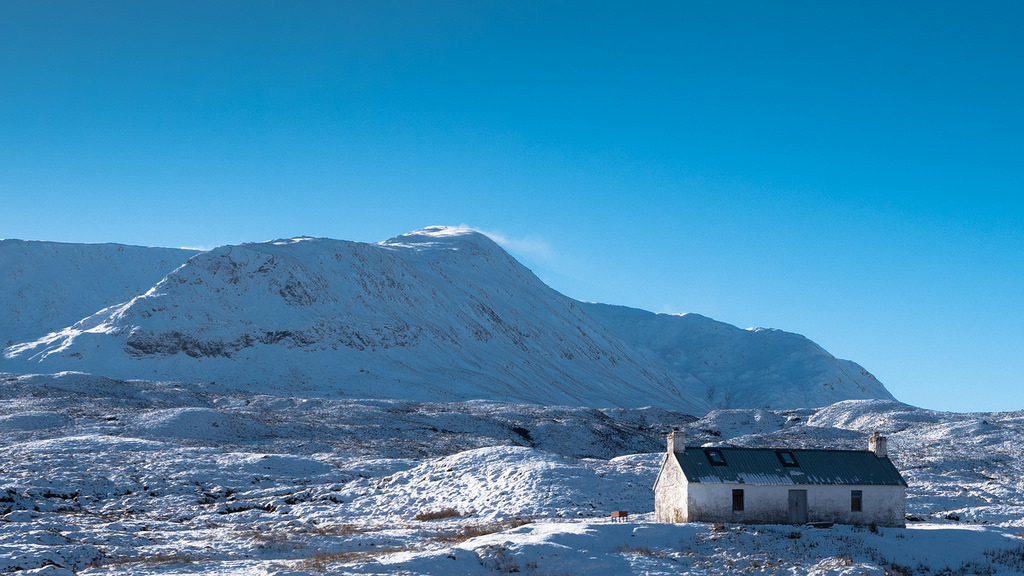
Nevertheless, as time progresses I am aware there is a cut off point beyond which I can't stay here. I have only a small amount of food left, and a bit extra I left with the bike, but not much. I need to leave here no later than noon. But if John doesn't arrive by then, we have a more serious situation anyway, I suspect. I decide not to worry prematurely, and John appears half an hour later.
He is visibly exhausted and the bottoms of his walking poles have turned into giant ice balls. Yet, he doesn't stay long, just enough to eat, change some clothes, and have a go at the ice balls with an ice axe. In spite of the very hard snow conditions he is determined to carry on. Having been up there just a few hours earlier, I know exactly what he is up against, and I find the level of mental stamina required to carry on quite astonishing.
There is no question of me joining him for Sgurr na Lapaich. I am too spent, and my right heel is rather tender, has been since midday of the previous day. I suspected a giant blister to start with, but as there was nothing to be done about that until I got to the bothy, I didn't bother. But to my surprise, when I took my socks off previous evening, there was no external damage, which is more disconcerting than a giant blister would have been. So I need an easy option.
The relatively easy exit route takes me into the bealach between An Cruachan and An Soccach, down a stalker's path along Allt Riabhachain and then through the Drochaid nam Meall Bhuidhe bealach to pick up the path leading into Glean Innis an Loichel. It's been overcast since mid day, but the sun comes out for a bit in the afternoon just as I enter the glen. Then a bit of road running to get back to Monar Lodge. All in all just under six hours.
The pain in my right heel has got progressively worse during the day, and for some reason is particularly acute on the bike. But there is no snow left on the road, and I can see some serious weather coming in, so push hard, taking just seventy five minutes to get back to the car. But not before the weather arrives, the last part of the cycle in freezing rain and stinging hail. I spare a thought for John up there on the high ground, better him than me.
Off to Beauly where I devour a fish supper. I hope I'll be able to stay in the Bunkhouse again -- John was hopeful of a 36h finish, so we did not book another night. I am in luck. Early start next day, back at Struy for 5:30am as agreed. I try to sleep in the car for a bit more, but it gets too cold without the engine running, so I get up and go for a walk. I get a call from John at 6.30am -- he has only six miles left, but says he is moving slowly.
The big question is what is 'slowly' in the Fleetwood parlance? I expect it's more like my fast than my slow, so start walking up the forest track John will come down to meet him. Another nice cold morning. Just before the track emerges from the forest, there is a giant, iced over, and hard to avoid, puddle and I lament not wearing walking boots.
Once on the open hillside I can see quite far, but there is no sign of John. I wonder if we might have somehow missed each other, and hurry back. As I do, I register another, quite appealing, forestry track going off to the right, which under different circumstances I'd explore, but the last thing I want is for John having to wait for me.
No sign of John at the car, so I get the camera out and head back to the village, to take pictures of snowdrops and study the grave stones, as you do. There is lot of history here, but not much life. I chat to a couple of drivers of forestry trucks waiting for the time when they are allowed into the forest.
Time moves on, three hours and counting since the call. I keep an eye on the track on the hill, but no sign of John. Then a rather dishevelled figure emerges down the road; I take do a double take, the direction is wrong, but yes, it is John, with tales of a dead end forestry tracks and dense sitka. I am very glad to see him, the last couple of hours I was beginning to worry about him for the first time since he set off.